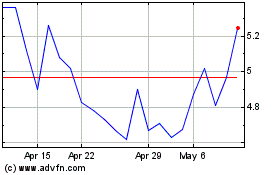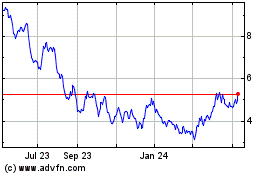Implats - Annual Results 2013
29 August 2013 - 5:00PM
OTC Markets
IMPROVED SAFETY
PERFORMANCE
BUT OPERATIONAL AND MARKET CHALLENGES
REMAIN
Impala Platinum Holdings Limited (Implats) has announced results
for the full year ended 30 June 2013 today.
Implats? CEO, Terence Goodlace commented,
?It has been a good year for the group from a safety improvement
perspective. However,
it has been a challenging one in terms of operational performance
at Impala Rustenburg, a changing workforce dynamic and weak market
prices.?
Key features
- Safety ? improved across all indicators
- Production - gross platinum production up 9% to 1.58 million
ounces
- Costs - lower refined volumes at Impala contributed to the
increase in unit costs
of 23% to R16 570 per platinum ounce
- Revenue - increased by 9% to R30 billion
- Earnings - headline earnings decreased by 52% to R2.0
billion
- Dividend - a final dividend of 60 cents per
share
Safety
Safety improved across all leading and lagging indicators for
the Group. The fatal
injury frequency rate improved by 25.3% to 0.065 per million man
hours worked and there were no fall-of-ground fatal accidents,
which is a considerable achievement. The lost time injury frequency
rate improved by 15.1% to 4.21 per million man hours
worked. Regrettably,
we had nine fatalities during the year. The board, management and all of
the Implats team extend their sincere condolences to the families
and friends of the deceased.
Financial
review
Revenues, at R30.0 billion, were R2.4 billion higher than those
achieved in the previous period. Headline earnings per share
decreased by 52% from 685 to 330 cents per share due to operational
performance at Impala, above inflation cost increases and
impairments of R1.3 billion of long-term receivables (excluding the
goodwill impairment for the Afplats
transaction).
Capital expenditure of R6.4 billion, the bulk of which was
spent on the development of 20, 16 and 17 shafts at Impala
Rustenburg and the Phase 2 expansion project at Zimplats, was
mainly funded by cash generated from operations which amounted to
R5.9 billion (2012: R5.0 billion).
The board has decided to declare a dividend for the year of 95
cents per share which comprises an interim dividend of 35 cents and
a final dividend of 60 cents per share. This is in line with the Implats
dividend policy of 3.5 times cover.
Market
Global economic conditions continued to impact on the PGM
markets, with US$ prices for all our major metals lower than the
prior year. For
calendar year 2012 the platinum market moved into a deficit of half
a million ounces on the back of reduced primary supply from South
Africa and a marginal increase in demand from the automotive
sector. Non-automotive
industrial demand was lower reflecting weak economic conditions but
an uptick in jewellery and investment helped support the
market. The anaemic
pricing environment stunted any growth from the recycle
sector.
Palladium demand continued to grow on the back of stronger US
and Chinese automotive sales combined with positive investor
sentiment. This drove
the market towards a sizable deficit of nearly 900 000 ounces.
The deficit was compounded by a reduction in Russian stock
deliveries adding to the belief that future liquidation from this
source will be limited.
We
anticipate further growth in global vehicle sales of 3 ? 4% per
annum, which when combined with tightening emission standards
should provide a solid foundation for increased demand for our
metals. This will result in deficit markets for platinum and
palladium which will not easily be met from increases in primary
supply, particularly from South Africa where operational challenges
and the lack of capital investment by the industry will continue to
suppress supply into the foreseeable future. This should prove positive for
prices in the medium to long term.
Operational
performance
Gross refined platinum increased by 9% to 1.58 million ounces
compared to the prior year. Mine to market output decreased
by 2% to 1.21 million ounces primarily due to lower volumes from
Impala. Non-managed
production increased by 80% to 368 000 ounces as a result of
once-off treatment for third parties. The lower volumes at Impala
negatively impacted on group unit costs, which increased by 23% to
R16 570 per platinum ounce.
Impala
Ore milled increased by 2.3% to 10.9 million tonnes while
refined platinum decreased by 5.5% to 709 200
ounces. Unit costs
increased by 23.9% to R17 241 (2012: R13 913) per refined
platinum ounce.
Above inflation wage and power cost increases combined with lower
production affected unit costs.
The mine is currently face length constrained and only mined an
average of 17.4 kilometres of face at an average panel length of
21.7 metres and a face advance of 10.3 metres per
month. The key to
reversing this situation is to optimise development, equipping,
construction and ledging activities on existing shafts and at the
newly commissioned 20 and 16 shaft complexes. The team at Rustenburg are
implementing a number of key initiatives to improve the overall
performance of the mine. These initiatives are focused on
planning and executing on optimal mine designs, increasing on-mine
motivation and increasing the skills and knowledge of the
teams. In addition, an
improved mineral resource management approach has been
adopted.
Marula
Ore milled increased by 3.1% to 1.6 million tonnes while
platinum in concentrate increased by 3.8% to 71 700
ounces. Costs per
platinum ounce in concentrate increased by 19.3% mainly due to
inflation of 11.5%, the employment of an additional 290 employees,
unforeseen conveyor belt maintenance, trackless machinery repairs
and external consulting costs. As a result of the external
intervention during the first half of the year, in-stope
productivities have increased by 8.5%.
Zimplats
Ore milled increased by 6.6% to 4.7 million tonnes while
platinum in matte increased by 5.9% to 198 100 ounces despite
the smelter fire in December 2012 which necessitated a shutdown of
21 days. Platinum unit
costs in matte increased by 5.5% mainly due to US$ inflation of
6.2% offset by the increase in platinum production. The unit costs for the year were
US$1 307 (2012: US$1 239) per platinum ounce in
matte.
Mimosa
Tonnes milled at 2.4 million for the year increased by 2.5% and
platinum in concentrate reduced by 5.4% to 100 300
ounces. Mimosa?s unit
costs increased by 22.6% to US$ 1 782 per platinum ounce in
concentrate mainly due to the lower production, Zimbabwean
inflation, the impact of a stock rebuild exercise post the 2012
fire and the higher usage of plant chemicals and
reagents.
Two Rivers
Tonnes milled were 2.2% higher at 3.2 million for the
year. Platinum in
concentrate increased by 8.2% to 162 200 ounces. Costs per platinum ounce in
concentrate increased by 8% to
R11 683.
Zimbabwean indigenisation
The termsheets setting the conditions for the proposed
Indigenisation Plans for both Mimosa and Zimplats were submitted in
December 2012 and January 2013 respectively. We have been notified that
termsheets need to be revisited. Discussions are
ongoing. Zimplats has
lodged a formal objection and a compensation claim for the
compulsory land acquisition gazetted on 1 March
2013.
Prospects
We
firmly believe that the demand for our metals will increase in the
medium- to long-term driven primarily by the growth in global
vehicle sales.
However, future primary supply growth will remain constrained which
will result in tighter market conditions leading to higher prices
for our metals.
We
continue to invest in our replacement projects, which are essential
to restore Impala?s production profile. We will maintain production in
2014 at current levels and thereafter progressively grow output to
850 000 ounces of platinum per annum by 2018. This, coupled with the completion
of the Phase 2 expansion project at Zimplats, will ensure the
sustainability of the Group.
Ends
Impala Platinum (QX) (USOTC:IMPUY)
Historical Stock Chart
From Dec 2024 to Jan 2025

Impala Platinum (QX) (USOTC:IMPUY)
Historical Stock Chart
From Jan 2024 to Jan 2025
